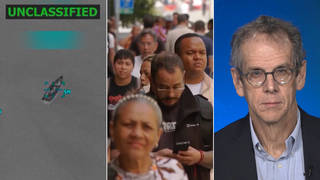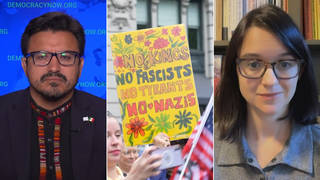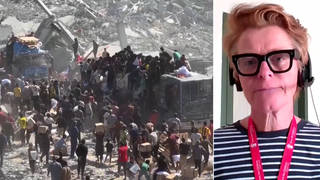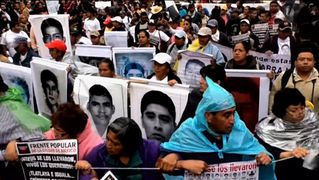
Independent reporter, activist and poet John Ross has been covering social movements in Mexico and Latin America for nearly fifty years. He is the author of ten books; his latest is El Monstruo: Dread and Redemption in Mexico City. Ross moved to Mexico City in the aftermath of the massive 8.1-magnitude earthquake in 1985 and has lived there ever since. [includes rush transcript]
Transcript
SHARIF ABDEL KOUDDOUS: In Mexico, every forty-eight minutes, someone is killed in the so-called drug war, this according to the national Mexican newspaper El Universal. A new internal report by the Mexican government recently found that nearly 23,000 people have been killed in drug-related violence in Mexico since a US-backed military crackdown on cartels began more than three years ago. The death toll rises each year. In the first three months of 2010 alone, more than 3,300 people have been killed.
AMY GOODMAN: Well, our next guest argues the US-backed war on drugs needs to end. John Ross is an independent reporter, an activist, a poet. He writes, quote, “Billions have been wantonly flushed down the drain since Reagan’s declaration of war in 1985 and the W word has become a much [bigger] business…Those of us who have opposed every US war from Vietnam to Afghanistan must demand an end to the White House’s War on Drugs.” John Ross has been covering social movements in Mexico and Latin America for nearly fifty years. He’s the author of ten books. His latest is called El Monstruo: Dread and Redemption in Mexico City. John Ross joins us here in our Democracy Now! studio, up from Mexico City.
Welcome to Democracy Now!
JOHN ROSS: Thank you, thank you.
AMY GOODMAN: Why the title, El Monstruo?
JOHN ROSS: El Monstruo, because Mexico City is a monster of a city, largest megalopolis in the Americas and possibly in the world, 23 million people living on a piece of land that does not really support them, where there is no water, where there is very bad air — no air — and their struggle to stay on this land, I think, has been epic. And the city is a monstruo in itself.
The Aztecs actually characterized the beginnings of El Monstruo, it was called Tenochtitlan, as an animal itself, and as the population grew, it acquired this name, El Monstruo. But it’s our querido monstruo, it’s our beloved monstruo, and this new book is really a defensive place of a totally indefensible place.
SHARIF ABDEL KOUDDOUS: And you moved to Mexico City in 1985, soon after the massive 8.1-magnitude earthquake that devastated the city. Talk about how that earthquake affected Mexico City.
JOHN ROSS: Sure, sure. I actually had spent a lot of my misspent youth in Mexico and was working in the Southern Cone dealing with getting organizations in the Andes when the earthquake occurred on September 19th, 1985. And I was working for Pacific News Service, and I was asked to go back into Mexico and follow what happened, the aftermath of the earthquake, because earthquakes all throughout Latin America have shaken up the social structures in those countries — Nicaragua in '72, Peru in ’70, and indeed Mexico is no exception.
I arrived one week after the earthquake, on September 26th, and settled into an old creepy hotel in the Centro Historico, where I still live, and became part of a movement of earthquake victims, damnificados, that organized a movement from which the civil society resurged in Mexico, very resurgent civil society. That movement evolved from the individual buildings. Each building was an organization unto itself. Each block was an organization. Each neighborhood was an organization. Within three weeks, we had put 100,000 people in front of the Mexican White House, Los Pinos. And with that pressure from down below, replacement housing precisely where the housing had come down — 30,000 people were killed, over 10,000 buildings damaged, 1,000 came down — but replacement housing was built exactly where it had come down due to the pressure from down below.
And that movement of damnificados, that movement of earthquake victims, very quickly translated into political terms. And the government was very inactive at the beginning, and people suddenly realized they could take care of their own lives. They didn’t have to depend on this party that had ruled Mexico for, at that point, sixty-one years, the Institutional Revolutionary Party, or the PRI. And one of my compadres, Lalo, said to me, “You know, John, before the earthquake, we thought the PRI would take us from the cradle to the grave, and afterwards we realized that we could do it for ourselves.” And that sense actually translated into, as I said, political terms.
The 1988 election, which was stolen from Cuauhtémoc Cárdenas — the left actually never has lost Mexico City since 1988. And when elections for the mayor were instituted as a result of constitutional reform in 1996 and 1997, Cárdenas became mayor of Mexico City, elected mayor. And there have been four mayors since then, all of them from the Party of the Democratic Revolution. No other megalopolis in the Americas, and perhaps in the world, has been run by a left party for so long. It’s been an interesting experiment.
AMY GOODMAN: Would you say Mexico City is where Subcomandante Marcos came from?
JOHN ROSS: Subcomandante Marcos, we haven’t seen for a long time, is actually from Tampico in the north, in the state of Tamaulipas. He went to the Autonomous University, to the UNAM.
AMY GOODMAN: In Mexico City.
JOHN ROSS: In Mexico City —- and then was -—
AMY GOODMAN: What’s his name?
JOHN ROSS: What was —
AMY GOODMAN: His name.
JOHN ROSS: Well, Marcos has never told us what his name is. The government has said it repeatedly, Rafael Sebastián Guillén Vicente. We haven’t seen him for a long time. He's been absent from the public stage for the last fourteen months, although there have been periods of time when he’s been absent longer. But at this point, he didn’t show up at the annual January 1st fiestas that occur as a result to mark the sixteenth year of the rebellion. And I have a feeling that Marcos is just the persona, he’s just the mask. And I have a feeling that that persona no longer fits the needs of the Zapatista movement, and we may not see Subcomandante Marcos again.
SHARIF ABDEL KOUDDOUS: Well, you just said there’s never been a left party that has run a major city for so long. What’s changed?
JOHN ROSS: A lot of things have changed. There were a lot of things to change. One of the things that I think has changed most radically is that the sense of community participation, the sense of citizen involvement, is the way things happen now. I go to two neighborhood meetings each week in the Centro, where I live. Hundreds of people come to these meetings and discuss what’s going on in the city, discuss what’s going on nationally, and discuss what’s going on in history, because this is the hundredth anniversary of the Mexican Revolution. So, you know, these are get-togethers in which the people know that the input in these meetings will be heard at city hall, just a couple of blocks away, as a matter of fact. So I think that’s what’s really changed.
But in terms of social amenities, thirteen years of a left party, things like abortion on demand during the first twelve weeks of gestation, free abortion on demand; same-sex marriage, as of March 4th, and now every week we’re having collective marriages; a right-to-die bill, with dignity; bicycling every Sunday, two days a week without cars — the air has gotten better, the gas been reformulated; a commitment to recycling. Mexico puts out about 20,000 tons of garbage every day, and that’s a lot of recycling to be done. All of these social amenities, I think they’re very distinct from the rest of Mexico and very distinct from the rest of Latin America. And sometimes it feels like Mexico City is San Francisco, you know? Those kind of things have changed, you know?
AMY GOODMAN: John, why did you move to Mexico City?
JOHN ROSS: I came in right after the earthquake, as I said, but way back in the '50s I was a member of a literary movement called the Beats. And I was a younger Beat poet, and I went to Mexico in 1957 with a number of younger Beat poets. We were much younger than the Jack Kerouacs and Allen Ginsbergs. We were about fifteen — well, not so much younger than Allen, but certainly than Kerouac and Burroughs. We were about fifteen years younger. But we had contact with them in New York. I come from the Village. I was born in the Village, and my contact was always with poets and artists, and came to Mexico in 1957, returned in 1958. And I didn’t go on the road. I mean, all the Beats were always on the road. I came and stayed.
And I lived for seven years in a small indigenous village in the mountains of Michuacán. And truly, you know, I've been very close to the Zapatista movement during the last sixteen years. And I could have not been close to the Zapatista movement, if I hadn’t spent so many years living in an indigenous community and understanding the dynamic of indigenous life in rural Mexico.
SHARIF ABDEL KOUDDOUS: And you spoke about the Mexican Revolution a hundred years ago. A hundred years before that, 1810, the war of liberation from Spain.
JOHN ROSS: Right.
SHARIF ABDEL KOUDDOUS: Every hundred years — what’s in store for 2010?
JOHN ROSS: Well, it seems that the Mexican metabolism kind of explodes into social conflict on the tenth year of the century — 1810, 1910, 2010. Will the revolution come again? I’m not the only one concerned with this. The Wall Street Journal ran an article on January 15th asking the same question. Their sense was that it wasn’t going to happen.
Objectively, at this moment, Mexico is overripe for social upheaval. The best social economists are telling us that four out of every ten workers who had a job don’t have a job now. That’s 40 percent unemployment in the formal sector. And millions of Mexicans have never had a job. They’ve always just sold in the street.
The situation in the countryside, I think, is very dangerous. The great influx of NAFTA corn, eight to ten million tons a year, 60 percent of it genetically modified corn, which is attacking 300 species of native corn. Corn is — you know, corn comes from Mexico 8,000 years ago. That influx of corn had, by the tenth anniversary of NAFTA in 2004, according to the Carnegie Endowment, it put 1.8 million farmers off their land. They could no longer compete in the internal economy. Each farmer has five in his family, so we’re talking about ten million people no longer on the land. And these are figures from 2004.
And generally, the movement has been to the north, to come to El Norte and cross the border and find work. Well, you can’t cross the border now. It costs you $5,000 to hire a coyote, and there’s no guarantee that a coyote will get you across the border. And your family will be pursued by the people-smugglers for the rest of their lives to pay this up. And so, that safety valve, which has traditionally been the way that younger Mexicans have been able to get out of this very difficult situation, is now closed down. And it’s very much of a pressure cooker situation.
Whether there are subjective forces to move in 2010 against the government is another question. And it takes, I think, a pretty deep analysis to figure out who’s out there and who’s not. Armed groups are generally not very demonstrative of what they have until they’re ready to move.
AMY GOODMAN: John Ross, very quickly, because Congressman Grijalva is waiting in Washington, DC to talk about the immigration laws, this draconian law that has just been passed in Arizona. But the effects of the immigration laws and the war on drugs?
JOHN ROSS: Well, certainly, I always assume — these are hot-button issues in the US press — immigration and drugs. Washington uses these issues to pressure Mexico, to win concessions, and they’re not necessarily concessions in terms of the drug war or immigration at all. They look at security, and they look at economy, and basically energy, you know? Washington wants to see Mexico privatize its oil industry, PEMEX. And so, they utilize this pressure that comes from immigration, comes from the drug war, in order to win those concessions.
Washington wants greater control over Mexico’s security apparatus, so they use things like the ASPAN, the security and prosperity agreement, to be able to — which would integrate security forces throughout the entire continent under Washington’s control. They use things like the North Command, which now penetrates Mexico’s airspace, because Mexico has been declared the southern security perimeter of the United States.
So those are the two aims of Washington at this point: to gain control over the Mexican security apparatus and the privatization of PEMEX. And all of this Mexico bashing that comes out of immigration and comes out of the drug war is really directed at that. And that’s how the White House has operated in Mexico as long as I’ve been there and much longer than I’ve been there.
AMY GOODMAN: John Ross, we want to thank you very much for being with us. He is the author of El Monstruo: Dread and Redemption in Mexico City. He’s on a book tour in the United States. He’ll be at the Harvard Coop in Cambridge, and then he’s on to the David Rockefeller Center on Latin American Studies. You can go to our website. We’ll link to his tour at democracynow.org.












Media Options